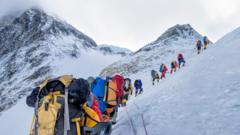The adjustments will also affect climbers targeting the mountain in off-peak months, with fees climbing to $7,500 from September to November and $3,750 during the winter months of December to February. The increased revenues from these permits are crucial for Nepal’s economy, where mountaineering and trekking activities account for over 4% of the GDP.
Despite this increase, there remains skepticism regarding whether it will diminish the high demand for climbing permits. Narayan Prasad Regmi, the director general of Nepal’s Department of Tourism, explained that the existing royalty fees had not been updated for a significant duration and thus required adjustment. However, he did not outline how the expected additional revenue would be allocated.
The concern about overcrowding on Everest has been accentuated by a 2024 Supreme Court ruling imposing limitations on the number of climbing permits issued. While the court recognized the need to respect the mountain's carrying capacity, it did not establish a specific cap.
Efforts to mitigate the impact of climber traffic are ongoing, including annual clean-up initiatives led by the Nepalese army, which has been crucial in managing the debris that has accumulated on the peak—often referred to as the world’s highest garbage dump. So far, these operations have retrieved 119 tonnes of waste and several human remains, but hundreds of bodies are estimated to remain uncollected.
With eight of the world's highest peaks residing in Nepal, including Everest, there is a persistent tug-of-war between preserving the natural beauty of the mountains and managing the burgeoning tourism that supports the local economy.
Despite this increase, there remains skepticism regarding whether it will diminish the high demand for climbing permits. Narayan Prasad Regmi, the director general of Nepal’s Department of Tourism, explained that the existing royalty fees had not been updated for a significant duration and thus required adjustment. However, he did not outline how the expected additional revenue would be allocated.
The concern about overcrowding on Everest has been accentuated by a 2024 Supreme Court ruling imposing limitations on the number of climbing permits issued. While the court recognized the need to respect the mountain's carrying capacity, it did not establish a specific cap.
Efforts to mitigate the impact of climber traffic are ongoing, including annual clean-up initiatives led by the Nepalese army, which has been crucial in managing the debris that has accumulated on the peak—often referred to as the world’s highest garbage dump. So far, these operations have retrieved 119 tonnes of waste and several human remains, but hundreds of bodies are estimated to remain uncollected.
With eight of the world's highest peaks residing in Nepal, including Everest, there is a persistent tug-of-war between preserving the natural beauty of the mountains and managing the burgeoning tourism that supports the local economy.





















